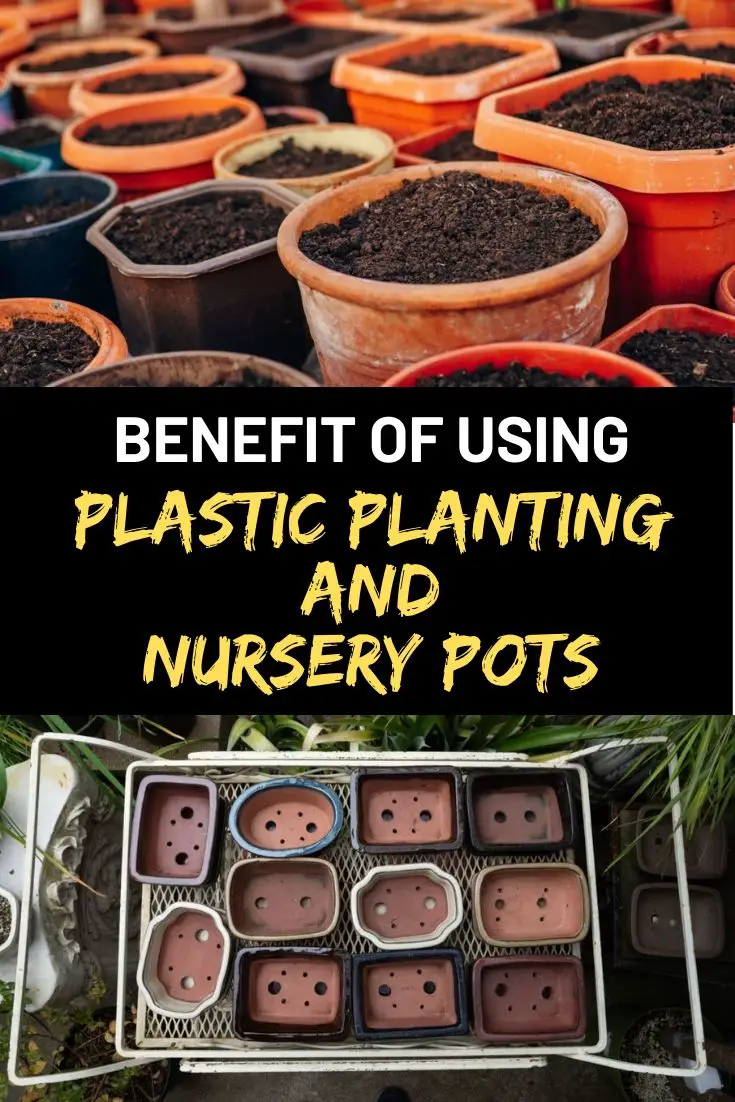What to Choose Modern Plastic Pots or Plastic Hanging Pots for your Plants?
Today more and more gardeners are using plastic planting pots. This is because compared to their clay counterparts, plastics have a lot of advantages.
Clay pots may be the norm of the past, but they are brittle and can be easily deteriorated through the test of time, which is the complete opposite of plastic pots. Plastic pots are durable, lightweight, and flexible. This means that they will last longer than clay pots, and no matter how you drop them, they wouldn’t break.
If you plan to use plastic pots for your garden, then here are some types you can choose from.
Heavy-Duty Round Nursery Pots (Plastic-Injection Molded)
Heavy-duty round nursery pots of this kind are made in a mold wherein the melted polymer is injected. The polymer is then cooled, taking the shape of the mold once it is removed.
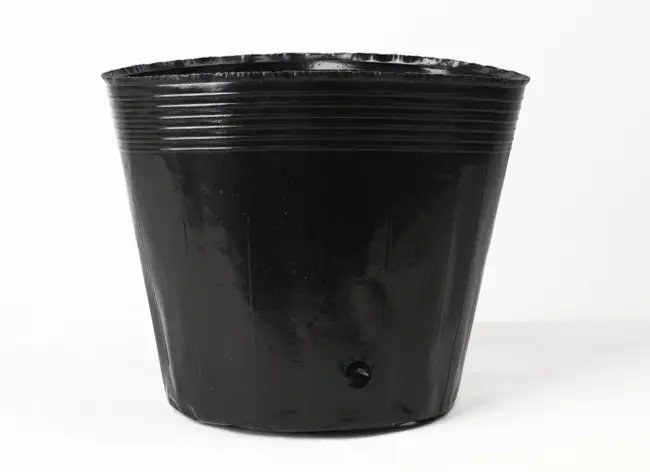
These pots are usually placed on the part of the nursery but are not usually for sale. They are best used for plants that you will transport frequently, and they can accommodate long-term growth. These Heavy-duty pots come in different sizes, such as the three dry quarts with a diameter of about 6.50 inches and a depth of around 7 inches. It can hold about 170 cubic inches of content.
On the other hand, the four dry quarts have a diameter of 7.625 inches and a depth of around 7 inches and can hold up to 232 cubic inches of potting media.
The six dry quarts is a bit bigger as it has a diameter of about 8.375 inches and a depth of 8.5 inches. It can hold around 605 cubic inches of potting media.
Slightly bigger than this are the 12 dry quarts with a diameter of about 10.625 inches and a depth of around 9 inches. It has the capacity to hold 605 cubic inches of potting media.
There are other different sizes, such as the 20 dry quarts and the 28 dry quarts, but the biggest is the 80 dry quarts with a top diameter of about 19.675 inches and depth of 16.875 inches allowing it to hold 5376 cubic inches of potting media.
Standard Duty Round Nursery Pots (Plastic-Thermoformed)
Thermoformed Standard Duty Round Nursery Pots are manufactured using a process wherein a plastic sheet is heated until it is pliable; it is then formed into a specific shape using a mold. After that, it is trimmed to create a finished product.
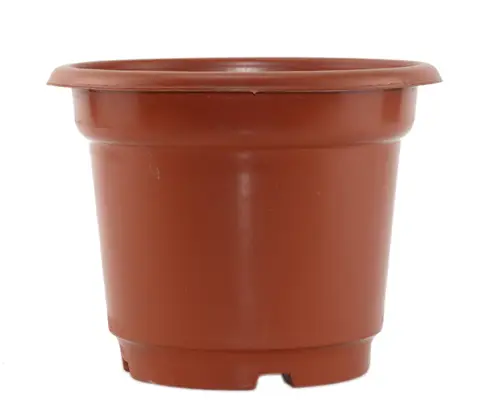
Like the injection-molded Heavy-Duty Round Nursery Pots, thermoformed pots also come in different sizes. From the three dry quart variants to the largest 20 dry quarts, you will surely have the right pot size you need.
Thermoformed pots also come in different shapes, as there are Thermoformed Square Plastic Pots available in the market today. These pots are designed for space-saving purposes.
Today no matter what kind of plant you have, there is a modernly designed plastic pot for it. By using plastic planting pots, you will get to save more and enjoy your garden without much hassle.
Advantage Of Using Plastic Nursery Pots
Unlike ordinary plastic containers, the ones manufactured for plant nurseries used a special plastic grade for long-lasting. They do not easily wear after many years of growing plants. Plastic nursery pots can stand against extreme weather conditions such as strong winds, the scorching sun, and the blistering coldness of winter.
Although they come in different sizes in terms of depth and diameter, the pots are definitely convenient as you can transport them from one place to another. In most nurseries, the plants are grown on pots that, when sold, are transported to their new place through a car or van.
People who bought plants on pots do not have issues with the transfer. Even in the house, the owner can transplant the plant or continue the cultivation through the pot. Either way, the plants can grow healthily.
An advantage of using plastic nursery pots is that they come with holes. The holes are critical in growing plants because the soil needs drainage, lest the plant gets soaked with water, causing it to wither.
Moreover, the designs of plastic nursery pots are nice. You can grow flowering plants or herbs and place them indoors in the living room or reception area with them. Even the colors vary from brown to black to maroon.
Using Plastic Planting Pots In Your Small Home Garden
If you want to use some plastic pots to grow your plants, here are some kinds of pots now available in the market.
Standard Duty Nursery Round Thermoformed Pots
You can see many of these pots in some nursery gardens, but you will hardly see them for sale. This kind of pot is available in different sizes, such as a three dry quart that has a measurement of seven inches deep and 6.375 inches in diameter, and it can hold a potting media of 173 inches in cubic.
There is also a four dry quart which has a measurement of seven inches deep, 7.625 inches in diameter, and can hold for up to 225 inches in cubic of media. A six dry quart is available, which measures 8.5 inches deep, nine inches in diameter, and can hold for up to 375 media in inches.
Another is a twelve dry quart which measures 9.5 inches deep, eleven inches in diameter, and can hold for up to 699 inches in cubic media. The last kind of this pot is the twenty dry quarts which measure 9.625 inches deep and twelve inches in diameter.
Heavy Duty Moulded Nursery Pots that are Round Plastic Injection
If you want to move your plants a lot, this kind of pot will be the one for you. As the first kind of pot, this can also be seen in some nursery gardens but is not sold. There are different sizes available such as the three dry quarts, which measure seven inches deep, 6.50 inches in diameter, and can hold a potting media of 170 inches in cubic.
Next are the four dry quarts, which measure seven inches deep, 7,625 inches in diameter, and can hold up to 232 media of cubic inches. Another is the six dry quarts which measure 8.5 inches deep, and 8.775 inches in diameter, and can hold up to 605 media of cubic inches.
Twelve dry quarts measure nine inches deep, 10.625 inches in diameter, and can hold up to 605 media of cubic inches. Twenty dry quarts measure 10.625 inches deep, thirteen inches in diameter, and can hold for up to 968 media of cubic inches.
Twenty-eight dry quarts measure fifteen inches deep, sixteen inches in diameter, and can hold up to 4032 media of cubic inches.
Lastly, the eighty dry quarts, which have 16.875 inches deep, are 19.6354 in diameter and can hold for up to 5367 media of cubic inches.
You can easily move your pots because of these easy-to-carry tray pots, which are very light in weight. These carry pots are available in two different sizes only. The first one is available from one hundred trays to a single tray pot. It measures 3.5 inches and can hold up to eighteen 3.5 inches pots that are square. The second one measures 4.5-inch trays and can hold up to 14.5 inches of square pots as well.
Plastic Planting Pots that are Thermoformed Square
These plastic planting pots are light in weight that is available in cases of pots or individual pots. They are available in different sizes, such as a square pot that is 2.25 inches. It measures three inches deep, 2.188 inches in diameter, and can hold for up to 8.85 cubic inches of potting mix.
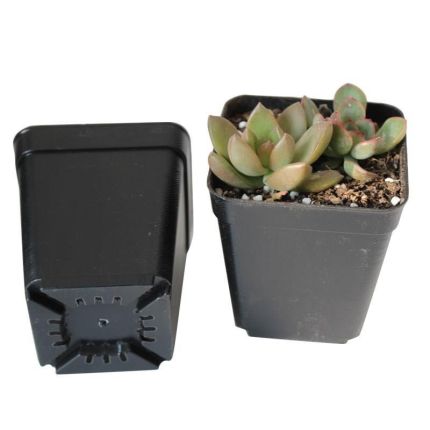
There is also a 3.5 inches square pot that measures 3.5 inches deep, and 3.5 inches in diameter, and can hold up to 31.21 inches of potting mix. The last is the 4.5 inches square pot which measures 3.625 inches deep, 4.188 inches in diameter, and can hold up to 48.82 inches of potting mix.
Most of the Plastic Planting Pots Are Ready With Drainage Hole
Plastic pots come in varied colors and sizes to fit your needs. They are also unlike clay; plastic pots are excellent for plants that need frequent watering. Their walls are thinner than clay pots and thus, provide effective insulation.
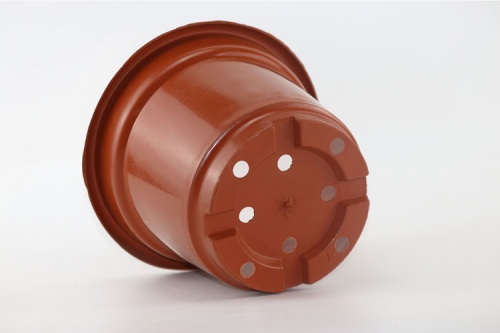
Good insulation is best for roots not to rot as it allows air to enter the pots and aerate the plants from any moisture left. Most plastic plants are ready with drainage holes at the bottom to ensure that plants are not soaked in water.
Dark plastic planting pots can act as solar collectors. They are not desirable for plants that do not need direct sunlight. Unless they are coated with UV protection, dark plastic pots are ideal for indoor plants. Plastic pots with UV light inhibitors are best for outdoor plants, especially if placed in areas with direct sunlight exposure.
Pots with UV-stabilized polypropylene can last for up to 5 years even when exposed to high sun and heat levels.
Most plastic pots are more affordable than any other plant container. Their lightweight makes them convenient for transferring from one location to another, compared to hefty clay pots. Plastic planting pots of higher grades can be more durable and rustproof.
How to Clean Your Plastic Planting Pots By Applying Soap
Since water evaporates easily from a clay pot, you’ll need to water the plants more. If you’re using plastic planting pots for your plants, the water tends to get sealed in and evaporates less, so the plants don’t need much watering.
You can easily rinse or clean your plastic planting pots by applying soap. They’re not heavy and easy to handle, making them easier to rinse and clean up. When you transfer a plant to your plastic planting pots, it’d be easy for you to clean it up for the plant to be transferred. Wash them with hot water and soap, then rinse them very well so that no chemicals from the soap will remain.
When you use a plastic planting pot for your plants, especially when it’s clear, you’d be able to monitor the plant’s roots. You can take notice if they’re growing properly at the right speed and at the right time.
It’s really beneficial for you to use plastic planting pots in your gardening needs because they bring plenty of benefits! Like you’d have lesser trouble in watering them since they won’t need your attention as much as plants planted in clay pots do.
You can even design your plastic planting pots depending on how you want them. You can add a personalized touch to it. Remember that using a plastic planting pot is easier because it’s light and easy to move around. You can carry it without having a hard time, and redecorate your garden without needing help.
Did you find this post useful? Would you like to get back to it later? Save THIS PIN below to your gardening or flower board on Pinterest! 🙂
